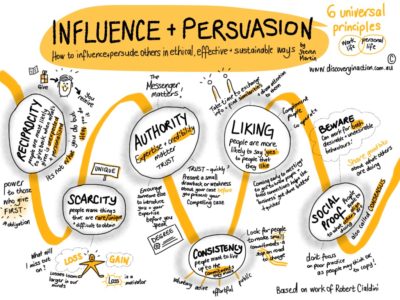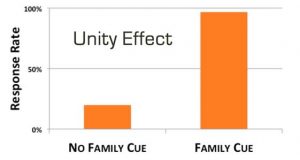Previously, we talked about Dr. Robert Cialdini’s six principles of persuasion, which he describes in his book Influence: The Psychology of Persuasion. The book was written over thirty years ago. But it remains one of the most prominent resources on the subject, having influenced generations of marketers including those currently in the biz.
Cialdini’s work hasn’t stopped there, though. He now has a new book out called Pre-Suasion: A Revolutionary Way to Influence and Persuade, which discusses a new, seventh principle: unity.
But before we get into that…
A Quick Review Of Cialdini’s 6 Principles

1. Reciprocity – People tend to want to return favors, to reimburse “social debts.”
2. Consistency & Commitment – People strive to maintain a self-image that aligns with what they believe and value.
3. Social Proof – People are more likely to do things if they see other people doing them (monkey see, monkey do; safety in numbers).
4. Liking – The more you like and trust a person, the more likely you are to be persuaded by that person.
5. Authority – People have a tendency to listen to people in positions of authority.
6. Scarcity – When something is believed to be rare or hard to come by, people tend to want it more. This stems from the fear of missing out.
The Unity Principle – What Is It?
The unity principle is related to the liking principle but differentiates itself by moving beyond surface-level similarities to tap into shared identities, or the need to feel like you belong, as a means of establishing relationships between “influencers” and “influencees.”

Dr. Robert Cialdini: “The experience of unity is not about simple similarities…It’s about shared identities. It’s about the categories that individuals use to define themselves and their groups, such as race, ethnicity, nationality, and family, as well as political and religious affiliations.
A key characteristic of these categories is that their members tend to feel at one with, merged with, the others. They are the categories in which the conduct of one member influences the self-esteem of other members. Put simply, we is the shared me.”
How to use this principle for CRO:
“The most powerful manifestation of unity is being in the same family,” says Roger Dooley. “People go to great lengths, even risking their lives, to help genetically close relatives.”

And so, a powerful marketing technique is to leverage Cialdini’s unity principle in a way that evokes familial unity. And according to Dooley, you can do this by using “family-related language.”
For example, in response to what would become of Warren Buffet’s firm after he retired, Buffet wrote, “I will tell you what I would say to my family today if they asked me about Berkshire’s future.”
By mentioning his family in this way, Buffet infused a layer of trust into his message, making his response all the more convincing and persuasive. And you can do similar things with your marketing copy.
This technique can also work in other capacities aside from familial unity. Really, it can work well for any close-knit community or group that has a strong sense of self-esteem or pride. For example, college alumni groups and CrossFit aficionados. Colleges have mottoes, mascots, and sports teams and CrossFit has specific terminology and practices, all of which you could reference and use in your copy to establish group cohesion.

Other ways that you can use the unity principle are fostering a sense of exclusivity, being part of an “elite club,” and tapping into the “in-group, out-group” cognitive bias by positioning your company as going against the grain or being different from all the rest.
What do you think about Cialdini’s unity principle? How are you going to incorporate it into your marketing efforts?




